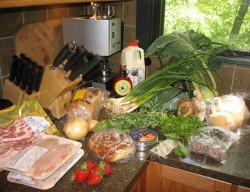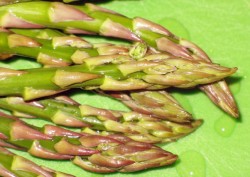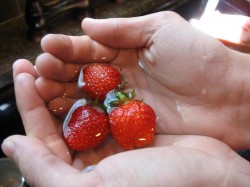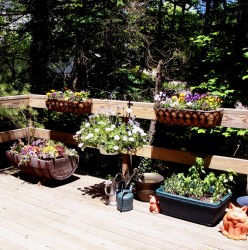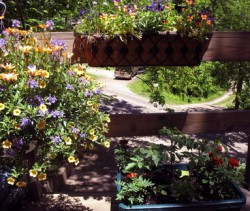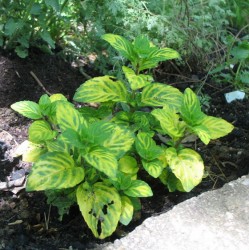The Locavore’s Bookshelf: Holy Cows and Hog Heaven
This self-published book, subtitled, The Food Buyer’s Guide to Farm Friendly Food, by Joel Salatin is probably one of the most important books a locavore can own. In a mere 129 pages, Salatin, the self-described Christian libertarian environmentalist capitalist farmer of Polyface Farm in Swoope, Virginia, explains the hows and whys of supporting local farmers who use sustainable methods of production. He lays his thesis out in readable, if fiery prose, then backs it up with facts and experience.
If, after reading this book, you don’t want to make the effort to run out and find farmers in your area and start eating the best food you have ever tasted, I fear there is no hope for you. Get thee to a McDonald’s if thou are not swayed by Salatin’s arguments, and never look back.
Salatin is a bit of a media celebrity these days, thanks in part, to Michael Pollan featuring him in a few magazine articles and most importantly, in his book, The Omnivore’s Dilemma. (Yes, I intend to review Pollan’s book soon, I promise.) But, don’t let Salatin’s “celebrity” status lure you into thinking he’s just another expert out to berate you by telling you what to eat, how to eat it, when to eat it and why to eat it.
Of course, he does all of those things, but his tone is not one meant to inspire guilt; rather, he just works to inspire the reader, period. He breaks down the process of turning away from the corporate grocery-store Wal-Martized food industry and opting into the alternative economy of locally grown food from farmers you can know and trust. He helps us re-humanize the food chain, in simple, straightforward language that is friendly, open, honest, and sometimes out-loud laughing funny.
Now, here is where I have to tell you something. Salatin’s rhetoric at times may make you think he might be a wee bit anti-government. Well, now, remember that second word in his self-description: “libertarian?” Yeah, you know, the folks who think that the government has a tad bit too much power? Well, in Salatin’s case, just when you think he might be coming off as a little shrill and paranoid, all you have to do is look up the laws and regulations he is talking about, and there they are, in black and white. He’s right–agricultural regulations and some “food safety” laws are detrimental to the small farmer and food producer. And being as he is one of those little guys who has made it part of his life’s work to agitate and try and get some of those regulations loosened up so that small farmers have a chance at making a decent living growing clean, healthy, sustainable food–you can bet he probably -has- drawn some government official’s ire here and there.
But even if you cannot get behind him on his deregulation crusade, what you can get behind is the enthusiasm he has for growing food following the footsteps of nature. Don’t let his talk of the Creator bug you overmuch, because you can insert “Nature” in place of that and go the non-theistic route in your head and find yourself still with Salatin, walking along beside him as he explains some of his philosophy of farming to you. As you grow to understand the elegant simplicity of Salatin’s methods, it makes so much sense that you wonder why more farmers aren’t doing the things he does.
What you will find out, if you go to your local farmer’s market, is that there are a lot more folks like Joel Salatin out in the countryside than you thought. Talk to your farmers, learn about what they do. They probably don’t do everything Salatin does at Polyface, but they probably use methods similar to his. They are probably just as passionate as he is about their land, their crops, their animals. Get them talking, and you will learn a hell of a lot more about your food than you thought possible.
That is the single most important theme of Holy Cows and Hog Heaven: the human connections that personalizing the food chain gives us.
When we buy food at the grocery store, we might know the clerks, or the produce stockers or maybe the guy at the meat counter, and we might chat with them, but if you ever ask them questions about this apple or that cut of beef, they really cannot tell you very much. They didn’t grow it, or cut it. They just took it out of a box and put it on a shelf, and they probably aren’t too excited about that. (Can you blame them?)
But a farmer who grew the food you are buying–why they can tell you the entire life cycle from seed to sprout to flower to fruit, from calf to cow to steak. And they lget excited when you ask them questions. They love it, because they have a passion for it; farmers who sell directly to the consumer almost always are driven by a great love for what they do. They have to be passionate, because they certainly aren’t making tons of money doing it.
So, Joel Salatin and I want to know–where would you rather purchase your food? From someone who doesn’t know about it and doesn’t care, and who is just the last link in a chain of faceless drones who brought this food to you across countless miles, in a condition that is probably not very well-filled with nutrients?
Or would you rather buy from the guy and gal down the road, who know each cow by name, who can tell you the pedigree of each apple tree on their farm, and who picked their corn fresh this morning and brought it five miles to market?
By now, you probably know which venue I try and choose every time.
If you are still sitting on the fence of the issue of local food, I hope you get your hands on this book and give it a read, and see if it sways you to give local, farm-fresh food a try. I am of the opinion that once you try buying from your neighbor, the experience of talking with them, of making a connection with them, and then eating that delicious food, will bring you back for me.
I know that is how it has worked with our family.
Athens Ohio’s Amazing Bounty of Local Foods
It really is amazing to me how many locally grown and produced foods there are available in a town the size of Athens. The resident population is around 21,000 with the Ohio University population, most of them students who only live in the town for roughly nine months of the year, roughly doubling the population when the university is in session.
Even though the town is small, with a household median income of roughly $17,000 with a median family income of $53,000, (contrast this with the US household median income of $26, 000 and the US median family income of $55,000 or $63,000 for married couple families) there is a very large, very vibrant community-supported local food network of farmers, restaurants, small food processors and small food-oriented businesses extent in and around Athens. Organic, locally-grown foods are a priority in this small town, and it just takes one visit to the local farmer’s market to learn just how strong this movement is here.
The illustration above shows a breakfast made almost entirely from local produce. The strawberries were grown here, the maple syrup was made here from sap tapped in Athens county, the bacon comes King Family Farm in Albany, Ohio, the bread was baked by Crumb’s Bakery, here in Athens, (though the wheat, alas, was probably still grown in Nebraska), the milk is from pasture fed Ohio cows and the eggs are from pasture-raised hens down the road in Guysville.
It isn’t hard, or that expensive to eat food this fresh and delicious in Athens–it is readily available and more and more consumers are choosing to go with Ohio food products rather than the typical coorporate foods available at Wal-Mart.
One of the most frequently-made comments against locally produced or organic foods is their higher cost to the consumer makes them prohibitively expensive for the lower-income consumer, leading to charges of elitism among those who support organic or local foods. (For my response to the Julie Powell OpEd piece making these charges, go here.) Yet. somehow, in this most impoverished county in Ohio, which is situated smack-dab in the middle of Applachia in which many residents suffer under-employment or unemployment, there has been a concerted effort to support the availability of good, wholesome, locally produced food.
How has this happened?
Through the concerted efforts of a great many individuals and groups working together toward common goals of financial support for local food growers, financial growth in an impoverished small-town and rural area, and social justice and food security for all residents.
One such committed group is ACEnet: The Appalachian Center for Economic Networks. The mission statement of ACEnet gives a taste of what the long-lived non-profit organization is all about: “he Appalachian Center for Economic Networks (ACEnet) is a community economic development organization located in rural southeastern Ohio. The mission of ACEnet is to build the capacity of local communities to network, innovate, and work together to create a strong, sustainable regional economy that has opportunities for all. ACEnet uses a sectoral strategy, currently focusing on the food and technology sectors of the economy.
In each sector, ACEnet staff provides basic service that businesses need to start, expand, and create quality jobs. At the the same time, staff members encourage entrepreneurs to network with each other, sharing information and generating joint ventures that enable them to enjoy economies of scale typical of much larger businesses.”
ACEnet has among its resources what it calls the “Community Kitchen Incubator,” one of a very few health-inspected food facilities in the country that can be rented by qualified individuals (ACEnet requires users to take classes in safety, health issues and operation of the specialized equipment in the kitchen) and small businesses in order to do commercial cooking, baking, thermal processing and frozen food processing. Included in the facility are shipping and recieving docks, warehouse areas, office space and conference rooms. These facilities have enabled unemployed or underemployed entrepeneurs to start successful small food businesses with distribution throughout the local area, as well as nationwide. In addition to facilities and education, ACEnet provides support for local food businesses in the form of further education and material assistance when needed.
Another organization that has done much to build the fantastic local food movement in Athens is Rural Action, another grassroots organization that is dedicated to promoting economic, social, and environmental justice in Appalachian Ohio. One of the specific projects of Rural Action is the support and growth of area farmers by bringing them together with both individual consumers of farm products and institutions such as Ohio University, thus providing needed economic support for local farmers. Indeed, the Rural Action Sustainable Agriculture program aims to educate farmers in adding value to their products, business skills and agricultural production techniques, while also identifying potential markets and increasing sales in these markets through consumer education.
Local restaurants have also made a difference.
Casa Nueva, the local worker-owned cooperative restaurant which has been in continuous operation for more than twenty years, has made a strong commitment for over a decade in sourcing food locally from farmers and producers as close to Athens as possible. They proudly also serve Free Trade coffees and teas, and really opened Athens residents and OU students to the ideals of eating locally long before anyone had heard the word, “locavore.”
The photograph above shows the range of locally grown and produced foodstuffs that are available through outlets such as the Farmer’s Market, The Village Bakery, and even the local Kroger’s Supermarket. Here in Athens county, we have an individual tapping maple trees and making syrup, several beekeepers, farmers raising sheep, goats, chickens, pigs, cattle, trout, catfish and even shrimp, several bakers, all with different specialities including European style hearth breads, farmers growing the standard crops one would expect along with Asian vegetables such as fenugreek greens, bitter melon and snake gourd, gifted confectioners and makers of raw-food treats and almond milk. We also have access to dairy products produced in Ohio including raw milk cheeses, fluid milk, cottage cheese, butter and cream. There are even those who make pawpaw butter and “popsicles” from our native tropical fruit and ramp pesto from our native wild onion. Goatherders make glorious goatmilk soap, scented with herbs, which is available from different outlets including the farmer’s market.
We even have a grower of some of the finest mushrooms you could hope to find anywhere. Up in the photograph above, you can see some gorgeous fresh shiitake, fat and full of flavor. I want to get some in the summer when the air is drier and try to make my own Chinese black mushrooms. That would be very, very cool.
The local Krogers stocks locally produced pastas, pasta sauces, salsas, tofu, barbeque sauces, jams and jellies.
And everywhere I look, it seems that there is someone else starting up a local food business, or growing some new food or bringing a new food product to market.
It is simple to eat locally here in Athens, and I am proud to say that our family does pretty well all year around, eating most of our food from local sources. It feels good to support our local foodshed, and I am pleased to feed us all with such nutritious, delicious and not that dearly expensive food (remember the low median incomes I cited above).
But, more importantly, I am proud to be able to serve such delicious food, raised and produced with great care and love.
Athens is a great place to live if you like good food that is produced locally and sustainably.
Author Peter Singer Critiques the Practice of Eating Locally
Zak sent me a link this morning to this Alternet article covering ethicist Peter Singer’s new book, The Way We Eat: Why Our Food Choices Matter, because he thought I would probably be interested in what he had to say about eating locally.
And I was. Singer is probably best well-known as the author of the 1975 landmark book, Animal Liberation, a volume which helped kick-start the animal rights movement and turned many carnivores into vegetarians. The Ira W. DeCamp professor of bioethics at Princeton University, and laureate professor at the Centre for Applied Philosophy and Public Ethics, University of Melbourne is considered to be a “practical ethicist,” basing all ethical considerations and constructions upon concepts of utility. Every action is examined under the completely objective lens of how much suffering the action will cause. Singer asks us to contemplate, “What is the best consequence this action can have?” before we take that action.
I feel rather silly, in fact, taking this 30-year veteran ethicist on and disagreeing with some of his points, since I am no philosopher, nor even ethicist, but I can’t help it. While I agree with much I have read of his opinions, not only in Alternet’s “It’s Not Enough to Be a Vegetarian,” but also the recent Mother Jones interview, “Chew the Right Thing,” and Salon.com’s “The Practical Ethicist,” I do not agree with all of his statements on eating locally, because he just does not make his case as well as he thinks he does.
When the Mother Jones writer asked him about the ethics of eating locally, here is what Singer had to say:
“You have to ask yourself what’s particularly good about being local. People say, “Well, I want to support my local economy.†But if you’re living in a prosperous part of the United States, what’s really ethical about supporting the economy around you rather than, say, buying fairly traded produce from Bangladesh, where you might be supporting smaller, poorer farmers who need a market for their goods? So I think that just in terms of supporting your local economy, I’d say no, you should support the economy where your dollars are needed most. But then people will say, “Yes, but there’s all the fossil fuel used in shipping it over from Bangladesh or wherever.†But people often don’t realize that if you’re shipping something like rice by sea, the fuel costs are extremely low. Shipping is a very efficient way of transporting. It may be that if you’re buying rice in California, the rice from Bangladesh has used less fossil fuel than California rice, even counting what it takes to get there. We also found that when we looked at tomatoes produced in New Jersey early in the season by being grown on heat, when you calculate the amount of oil that goes into heating the greenhouses, it turns out that you could have trucked them up from Florida with a similar amount of oil. If people are prepared to eat locally and seasonally, then they probably do pretty well in terms of environmental impact. But there’s not many people who live in the northern states of the U.S. who will say, “I’m not going to have any tomatoes between November and July.†So I think there’s a certain amount of double talk about local food that’s just too rosy.”
First of all, let’s examine this very wide-ranging answer point by point.
First, Singer assumes that he is talking to a person who is living in a prosperous area of the United States, when he says that we are better off ethically giving our money overseas to a Fair Trade farmer in Bangladesh than supporting already affluent rice farmers in California. (For the record, I buy imported rice, and agree with Singer’s points about California rice being grown unsustainably in fields artificially flooded by water piped in from other states, thus draining aquifers unnecessarily.)
However, I don’t live in an affluent area of the United States.
I live in one of the poorest counties in Ohio, where 51.9% of the population and 14.8% of the families live below the poverty line. Now, I reckon that by Bangledeshi standards, our farmers in Athens County are still rich, but the US is not Bangledesh. Not everyone in the US is living well, and I would like to support the people in my own community who are helping to provide good food that is grown sustainably and healthily with my money. Remember the catchphrase, “Think globally, act locally?”
Besides, shopping at my local farmer’s market does not preclude me from buying non-locally produced Fair Trade food products. Just a few seconds ago, in fact, I was nibbling on a bit of Fair Trade Certified chocolate, while my (decaf) morning coffee was shade grown Fair Trade organic Cafe Mam from Mexico.
On to Singers next point.
We also found that when we looked at tomatoes produced in New Jersey early in the season by being grown on heat, when you calculate the amount of oil that goes into heating the greenhouses, it turns out that you could have trucked them up from Florida with a similar amount of oil.
So, my answer to this is, “Don’t buy those crunchy, unseasonal tomatoes, dude. I don’t.” And I don’t. Nor do I buy them from Florida, because, frankly, whether they are grown hydroponically in a greenhouse in the winter or picked green in Florida and shipped north in refrigerated trucks, they taste like nothing, and why pay money for nothing?
Singer further remarks,
If people are prepared to eat locally and seasonally, then they probably do pretty well in terms of environmental impact. But there’s not many people who live in the northern states of the U.S. who will say, “I’m not going to have any tomatoes between November and July.â€
Okay, well, here is one of those “not many people” who refuses to eat “fresh” tomatoes between November and July, standing up, waving her arms and demanding to be counted by Singer and others.
I hate unseasonal “fresh” tomatoes, so I don’t buy them. Not at the farmer’s market, not at the greengrocers, not at Whole Foods, and not at the grocery store. I don’t give a darned if they are grown in Ohio, Florida, New Jersey or Holland, I am not buying them because they taste like utter crap. If I want tomatoes in the winter, I buy them canned, thank you. (Or I use the ones I froze myself during the summer glut.) They taste better than unseasonal ones and contain more nutritional value than the faux fresh ones in the marketplace in the winter.
One of the entire points of the Eat Local movement that Singer is either ignoring or is unaware of, is the principle of seasonal eating. We eat our fresh food in the season it is meant to be enjoyed, when it is at the peak of ripeness, when it is full of flavor and nutrients and when it really does cost less in energy to produce and bring to the “local” market. He can think that there is a “certain amount of double-talk about local foods that’s just too rosy,” but he is commiting the fallacy of making sweeping generalizations and painting an entire group of quite ethical eaters with a very broad brush.
I expect a better argument than that from the Ira W. DeCamp professor of bioethics at Princeton University and a man who is considered to be a “professional ethicist.”
At the end of the Salon article, the interviewer asked Singer what advice he would give to readers who might want to change their dietary habits after reading his book.
This is how Singer answered:
Avoid factory farm products. The worst of all the things we talk about in the book is intensive animal agriculture. If you can be vegetarian or vegan that’s ideal. If you can buy organic and vegan that’s better still, and organic and fair trade and vegan, better still, but if that gets too difficult or too complicated, just ask yourself, Does this product come from intensive animal agriculture? If it does, avoid it, and then you will have achieved 80 percent of the good that you would have achieved if you followed every suggestion in the book.
I am so with Singer when he says, “Avoid factory farm products.” I do avoid such products, and I will continue to urge others to do so, as I have done for years. The practices of industrial farming are cruel, unhealthy, unsustainable and in the end, produce a lower-quality product that may be harmful to human health.
I also will not argue with him when he says, “If you can be vegetarian or vegan,” that’s ideal, although I think that statement is not as absolute as he makes it out to be. I believe it is perfectly possible to be an ethical omnivore and eat some amount of meat, but I will give Singer that statement free of charge and let him make his request, because frankly, lots of folks eat more meat than is necessary, and if they slowed down a bit or stopped, it is probably not a bad thing.
However, when he says, “If you can buy organic and vegan, that’s better still…” I catch my breath and shake my head.
Because there is an inherent problem in that statement, one which I do not think that Singer, or many other vegans are aware of.
In choosing to buy organic food, which is arguably much better for the environment, they are supporting the meat industry, albeit indirectly.
How can this be, one might ask? Read on.
What exactly makes food “organic?”
It is grown without artifical, petrochemical-derived pesticides or fertilizers.
Okay.
So, where do the fertilizers for organic foods come from?
Animal manure. Specifically herbivorous livestock manure. Such as the stuff that comes from cows, sheep, goats, ducks, chickens and (admittedly omnivorous) pigs.
That is the flaw in the popular argument that if we fat Americans all just became vegans, the world would instantly be a better place, and animal suffering would end, and uh, all that horse-hockey. Because many vegans also are consumers of organic foods, and great supporters of organic agriculture as being more sustainable, I cannot help but wonder what kind of fertilizer they expect farmers to use if there are no more cows, chickens, pigs or sheep being raised for meat, eggs or milk.
There are other statements in those articles that Singer makes that I take issue with. It seems that he is against any sort of confinement for chickens, including rolling outdoor pens with open bottoms so they can scratch in the grass, eating bugs and plants, because such pens, even though they give ample room for the birds to move around and engage in natural behaviors, are, to his mind, too small. A few of his statements sound as if he is against egg farmers keeping chickens in coops with protected yards, too. I cannot help but wonder what kind of sense this makes since chickens have no real way to protect themselves from predators such as foxes, coyotes, bobcats, and even worse, feral dogs. (The former three animals tend to just kill to eat, so they take one or two chickens at a time, while feral dogs will tear apart a whole flock just for the fun of it. Believe me, I have seen it happen.)
I just want to say to Mr. Singer, “Sir, sometimes hens are confined to protect them from being killed by predators.”
I just get the feeling that Singer doesn’t understand that many small farmers feel very attached to their livestock, and care deeply about them being hurt, not because it hurts the bottom line, but because it is really awful to come home and see the devastation of a bunch of chickens torn to pieces senselessly in your front yard.
I don’t think Singer has spoken with very many small farmers, like the man I buy chicken from at the Athens Farmer’s Market. He told me about a flock of chickens he lost in an outdoor pen this winter, because the prevailing wind shifted, and was not blocked by the solid sides of the pen as usual. Instead, during a storm, the wind came from the opposing direction, swooping through the chicken wire, causing the chickens to huddle together for warmth. They suffocated each other before the farmer got to them.
When he related this sad story to me, the grief in the man’s face was obvious. “Those poor birds,” he said. “It made me sick to lose them that way. The poor little things.”
These are not the words of an unethical man who is not concerned witih the welfare of the animals in his care.
While I agree with his vehement arguments against CAFOs, feedlots and factory farming practices, I cannot help but think that Singer’s experience with the ways in which smaller, local farmers live and work is limited. I also feel that he either is ignorant of or ignores the nuances involved in the movement to eat more locally and sustainably.
That said, I did just order a copy of his book, so be prepared for a long review of it here on this blog sometime in the near future.
The Last of the Local Asparagus
Time passes; the season marches forward, and too late, I realize that I didn’t eat nearly enough asparagus.
The pound upon pound of it we bought and consumed through the early part of this month was apparently not quite enough to satiate my appetite for the emerald-green and violet spears, but that is life. The season is done; on Saturday, there was not a spear of it in evidence at any of the favorite stalls I haunt at the Farmer’s Market. Not a paltry bit of it was seen.
Too late, I realized that the last of the local asparagus had been consumed last Thursday in a pasta dish I put together to emulate and improve upon one I had in a local restaurant the week before.
And it was a delicious dish; don’t get me wrong, but I still would have liked to have known that we were eating the last of our favorite spring vegetable before it was gone. If only the farmers could have warned us by saying, “This is the last until next year–buy up and make gluttons of yourselves all week.”
I would have heeded them, and I suspect many others would have, too.
As it was, I had fun putting this dish together; I had it at a local somewhat okay Italian place, where the waitress assured me that it was the best dish on the menu. It consisted of asparagus, spinach proscuitto and chicken sauteed and tossed with penne, then sauced with a very light cream sauce that had brie melted into it.
It was pretty good, certainly edible, but not as good as it could have been. For one thing, there were no onions or garlic of any kind in the sauce in order to make for any deepened flavors; it was, in its way, dreadfully bland. The chicken, having come from Sysco, was not very flavorful, and the same could be said for the watery spinach and the somewhat tough asparagus. The proscuitto was not, in fact proschiutto at all, but instead was some sort of thickly cut, somewhat watery ham.
And, of course, they over-cooked the pasta.
I despise over-cooked pasta. Mush is not appealing to me, thank you very much.
So, of course, with what I did not know was the last of the asparagus, I set out to make a better version of the dish.
First of all, I started out with different ingredients.
I used caramelized spring scallions and green garlic as a flavor base, and sauteed them in olive oil. To that, I added a locally produced chicken breast that I had cut up into slivers and dredged in seasoned flour. I left off with the ham/proscuitto element altogether, and instead, deglazed the pan with a bit of dry sherry and chicken broth. The asparagus I used was younger and fresher, and instead of watery spinach, I used fresh chard leaves (the crisp ribs removed) cut into a chiffonade. The chard held up to the cooking better, had a nicer texture and actually had a great deal of flavor.
I also added a selection of herbs from my garden: lemon thyme and rosemary that I added during the sauteeing process, and both miniature globe basil and minature purple basil and chive blossoms, that I tossed on top of the finished dish for a fresh zing of flavor and color.
For the body of the sauce, I made a veloute, rather than a cream or white sauce. Veloute is nothing but a roux-thickened chicken stock, but I didn’t use any extra roux to thicken this sauce. I let it form naturally in the pan, from the flour I dredged the chicken in, the olive oil, and the chicken broth and sherry I used to deglaze the pan. This process formed a small amount of veloute that clung to the contents of the saute pan, and once I added the properly-cooked pasta, and tossed it to coat it with sauce, I added dollups of brie to melt into the sauce.
A note about the brie–I used the processed product called Creme de Brie. Generally, I eschew processed cheeses, but I do use this because there are some varieties of brie to which I am very allergic. This is because in some cheesemakers use types of penicillium mold is used in the production of the rind of brie, and I am very allergic to penicillin. Some brie cheeses make me very sick to my stomach, so in order to avoid that issue, I use Creme de Brie. For those who do not have the allergy issue–by all means, cut off the rind and pop whatever sort of ripe brie you like into the pan, and stir until it melts. More power to you! (And mind you, I am jealous. When I feel up to taking the risk, I will eat great real brie, and generally, if I am careful with taking off all of the rind–the place where the mold lives, I don’t get sick. But sometimes I am unlucky. And I decided not to take a chance on becoming too unlucky while I was pregnant.)
Penne with Asparagus, Chicken, Brie and Herbs
Ingredients:
4 tablespoons olive oil
4 large or 6 medium scallions, white and light green parts only, cut thinly on the bias (adds up to about 3/4 cup)
6 stalks green garlic, white and light green parts minced finely (makes about 1/2 cup)
1 tablespoon Aleppo Pepper flakes or freshly ground black pepper (I have found in Aleppo Pepper–a type of chile–a good subsitute for black pepper in food)
1 boneless, skinless breast of chicken, cut into pieces 1″X1/2″X1/4″, and tossed with about a tablespoon and a half of seasoned flour
1 tablespoon fresh rosemary leaves, stemmed and roughly chopped
1 tablespoon fresh thyme leaves, stemmed
1/2 pound pencil-thin stalks asparagus, ends trimmed as necessary and cut into 2″ long pieces
1/4 cup dry sherry
1/4-1/2 cup chicken broth or stock
1 large chard leaf, stem and stalk removed and reserved for another purpose, rolled up tightly and cut into very fine chiffonade
1/4 cup milk (as needed–you may have no need of it, or you could use more chicken broth)
3/4 pound penne, cooked in salted water until al dente
5 ounces Creme de Brie or brie cheese with the rind removed
2 tablespoons fresh basil, stemmed–if leaves are large, mince them finely, if they are tiny, leave them whole
florets from 3 chive blossoms, separated (pinch off the bottom bit that holds the compound flower together to get the florets apart)
Method:
Heat olive oil in a saute pan over medium heat. Add scallions, and saute until they are wilted and start to turn golden. Add garlic and Aleppo pepper or freshly ground black pepper and saute until quite fragrant–about one minute.
Add the chicken, and the rosemary and thyme and saute, stirring until it is mostly done–most of the pink color to the meat should be gone, with a golden brown crust over most of the chicken. Add the asparagus and let it pick up some of the browned flavors of being sauteed–about a minute.
Deglaze the pan with the sherry and boil off alcohol. Stir to get all of the browned bits from the bottom of the pan, and add chicken broth. Turn down heat and keep stirring until a thickened veloute forms, coating all the food in the pan thickly. Add chard, and keep stirring. (If the sauce is thicker than you like and a bit too gloppy, add some milk or more chicken broth to thin it appropriately.
Add drained pasta, and stir it into the sauce.
Add brie and stir, until it melts and incorporates itself int the sauce.
Put into bowls and sprinkle with basil and chive blossoms.
Note: This will serve four to five people; if you want to serve six or more, add a full pound of cooked pasta, and add more asparagus and chard, and add the extra milk or broth. Add one half tablespoon of flour to the chicken and maybe add a couple more ounces of brie. If you want, you can add more chicken, but I don’t think it is necessary. This is not a low-calorie dish, owing to the brie, but it is very filling and satisfying without much in the way of meat in it. It is all about the asparagus, chard, pasta and cheese, in my opinion, all seasoned beautifully with the scallions, green garlic and Aleppo pepper. The chicken is good, too, but not so good that I would want it to dominate the dish.
Needless to say, this is my last entry to Kevin D. Weeks’ of Seriously Good’s collection of asparagus recipes, “Asparagus Aspirations.”
To all things there is a season, and a time to every purpose under heaven, so the author of Ecclesiastes wrote thousands of years ago. The wisdom holds true, even today in this world of vegetables and fruits shipped from all over the world available at all hours of the day and night in the local supermarkets.
The time of asparagus has passed us, and until next year, we must say farewell to those beloved emerald spears. But, with each passing of something good, Nature grants us something new and lovely to take its place in our hearts.
Strawberries just came into season.
Since Saterday, our household has eaten a gallon of them, most of them out of hand. (I have to admit that we have had not a little bit of help from our friends, Donny, Dan, Heather, Bryian and Judi in that endeavor, however, so I don’t feel quite so gluttonous as I might otherwise.)
More on the joy of strawberries, later!
How Does My Garden Grow?
It is difficult to watch the rain pour down in a cool, wet spring, and not be out in the garden.
I spent most of last week, waiting for a break in the clouds, a temporary cessation in continual drizzle, then dashing out to dig a few holes, and plant a few new starts, or pull a handful of weeds here and there, deadhead some annuals, and fret over the basil plants.
I despair for my lovely planter box of basil; they started out so lush and full of promise, and now are going flabby and starting to wither.
It is the cold and wet. This has been one of the coldest, dampest months of May I can remember; our nights have been in the low forties for several weeks now, and the days have not been much warmer than the sixties. While the tomato plants chug along, happily setting forth new leaves and even setting blossoms, the basil pouts, drooping and weary.
I fear that I may have to replace the lot of them; they’re as tired and spent as old washerwomen, shoulders rounded, heads bowed, and waistes spindly.
But the rest of the garden flourishes, and grows into itself. The tomatoes are already setting blossoms up on the deck, the windowboxes and herb planters on the deck railings and floor, grow with abandon, and the potted and plantered annuals give a new show of exuberent color every day.
I cannot help but be pleased at that.
Down in the front of the house, along the retaining wall that defines the right side of our driveway, the mostly shaded garden border is alive with promise. It is a mixture of perennials and herbs that we started last year, and have added considerably to this year. It is patterned off of the colors, textures and shapes seen in the dappled shade of a forest floor; one can tell I grew up wandering the hills and bottomlands of my grandfather’s woodlot, soaking in the partnership between wood, water, plant and stone that makes the forest such a study in artless beauty.
My aesthetic sense was informed by those early experiences, but they were also morphed by my love of fairy and folklore as a young adult. The descriptions of the secret lands of Faerie and Neverland by Yeats and Barrie and the illustrations of Rackham and Froud also inform my garden design, leading me to adore variagated texture, deep colors juxtaposed with silvery foliage and sudden burst of brilliant bloom, and the infatuation with smaller plants, such as violets, primulas and corydalis–many of which have folkloric associations with the cparicious sprites the English common folk called “The Gentry,” or “The Good Folk” as terms of respect and appeasement.
The gardens of the East, particularly, Japan, also have lent their timeless, serene stamp upon my sense landscape aesthetics. The use of natural materials, of plants harmoniously planted to simulate the ways in which they grow in nature, and the use of minature plants to create small landscapes, finds expression in the gardens that Zak and I create. This very naturalistic style is most evident in our shady areas; in the sun, I am wont to let my love of the English cottage garden hold sway, with flowers growing in an enthusiastic jumble of blossoms, all running wild and rampant, in a glorious profusion that gives my spirit great satisfaction and quiet joy. Letting morning-glory vines twine themselves around the stems of sunflowers, then ramble over a hedge of lilacs just makes me smile as the blue trumpet flowers make a halo around the great shaggy yellow sunfaces of their host.
The English cotter’s tendency to mix food plants, culinary herbs, medicinals and decorative plants into a great tangle also has invaded my design sense. Ifyou look closely at my photographs of the shade bed that looks very woodland Japanese, you can see miniature purple basil, several varieties of thyme, sweet woodruff, catmint, and several other varieties of mint, all interspersed with the strictly ornamental plants like the heucheras and Japanese painted ferns. At the end of the month, when we start working on the other side of the driveway area, this one in sunnier locale, there will be even more obvious mixtures of the ornamental and the useful: garden sage, mint, bergamot, echinacea and valarian, all culinary and medicinal herbs, will grow freely among the shasta daisies, rudbeckia, iris, and salvia.
This coming week, we have an appointment with a man who does stonework for gardens. We want him to help us put large stones in to help retain a bit of clay subsoil that is washing out, and to pave an area next to the hot tub (it came with the house) that sits outside our side door. After he has done the heavy work of putting in the drainage and the stones, Zak and I, and our dear gardening helper Dustin (who does the things that I am not allowed to do now that I am pregnant, like dig trenches and shovel great piles of compost and manure, in addition to mowing the crazy slope of our back yard.), will put in pockets of good rich planting soil among the stones and plant ostrich ferns and hostas among the boulders, brightening the corner next to our garage that is perpetually shaded by our deck above. One springtime benefit that the ostrich fern plantings will bring in future years will be crops of fiddleheads in the early spring, just as the bamboo we plan to plant around the hot tub to screen it will offer edible shoots that I can prepare from scratch, instead of using canned.
While we have the master stoneworker here, we will have him look at the expanse of slope in our backyard. This is the best gardening space our property offers–it is a wide semi-circle of beautiful, arable land, all of it, unfortunately, on a forty-five degree slope that is very treacherous to clumsy pregnant-woman feet. (Needless to say, I only gaze upon it from afar now.) It is bounded by mature trees, and bordered on two sides with hedgerow, and it gets hours of full and dappled sun each day. We want this man to take whatever machines he needs to cut terraces from it–we have in our heads to make them irregular and composed half of straight angles and half of graceful curves, in the manner of rice paddies–so that we can then remove most of the lawn from our landscape, and instead garden to our hearts’ content.
What do we want to put in?
I should like a few fruit trees, but would be content with blueberries, strawberries and maybe some raspberries–the blueberries and raspberries along the hedgerow, with climbing roses and native honeysuckles. We must have our own asparagus patch; not only will it give us gustatory pleasure for years to come, but the ferny-airy growth of the plant in the summer can make a lovely backdrop to any number of other plants. Herbs, for certain will be dotting the terraces, tucked in here and there. I cannot resist poking them in wherever they will fit and grow; thyme particularly, will have to be planted to spill over retaining walls and creep along stonework. Roses, too, will be a part of garden, for if there is one thing that both Zak and I miss with a longing that is both sad and deep, it is our roses–beautiful queenly blossoms that brought fragrance and sensuality to our gardens.
And, to our kitchen, for that matter. I will tuck into the landscape as many edible flowers and plants as I can, all the while noting how beautiful they are alongside the strictly ornamental flowers and plants that grace the gardens of people primarily concerned with aesthetics. I am reminded every time I look at a tomato plant, for example, for how many years tomatoes were grown in Europe and America as strictly ornamental plants, grown for the lovely fruits that people admired for their beauty, but refused to eat.
How, then does my garden grow? It grows with love, and care and nurturing, and in return, it nurtures me back. It grows in my dreams, and I believe that its dreams grow into me.

It is hard for me to write this now, in fact, for the sun is shining, and the garden calls me. There are always a few weeds to pull, a bit of mulch or compost to place, or some seeds to plant. I still have my methi seeds to sprout yet, and put into pots. I still need to run out to find some good garden sage and tarragon for my last herb planter, along with some good Greek oregano and another rosemary or two.
I will go now, then, and dash out into the sun, and let the garden whisper her secrets to me, as I strain to listen and catch them all.
Powered by WordPress. Graphics by Zak Kramer.
Design update by Daniel Trout.
Entries and comments feeds.



